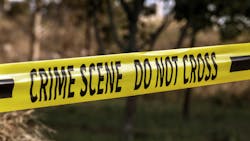Evidence at the Contact Point
For many officers who are not actually assigned as an evidence specialist, crime scene investigator or other duty that focuses on evidence as the primary item in the day, what actually consists of “evidence” can be perceived very differently from officer to officer. For larger agencies that have dedicated crime scene and evidence specialists, most of this article will be unnecessary. Those evidence specialists already know, all too well, the dos and don’ts of crime scenes. But for those smaller agencies who leave evidence collection either to their officers or their detectives, we’re going to take a closer look at what evidence is, can be, where it is, etc.
This article appeared in the January/February issue of OFFICER Magazine. Click Here to subscribe to OFFICER Magazine.
Let’s begin by recognizing that a crime scene can be limited in size and location, or it can be quite extensive. For example, most officers don’t consider a track, as performed as a K-9 team, a crime scene, but as there might be evidence found anywhere along the track, it may well be considered an extension of the crime scene. In one home burglary case, the officers arrived on scene within just a few seconds of the call being dispatched. As they were arriving at the front of the residence, the burglar went out the back door. Among the items that he had quickly picked up and stuffed in his pockets, he also was carrying a soda that he’d stolen from the refrigerator. Along his trail of running, he had to hop a fence and he dropped the soda bottle. After he was caught and arrested, he was physically connected to the bottle via his fingerprints and the bottle was connected to the residence he’d burgled by the lot number that was on the label—and the label on the wrapper of the six-pack of that type of soda—in the residence refrigerator. In that particular case, while the track wasn’t considered a crime scene or even part of it, it became an extension because the suspect dropped evidence along the way.
So, we see that our first lesson is never to assume where the crime scene starts and stops. Usually, you can identify it by existing physical barriers. If a murder occurs in a room, that room is usually the crime scene—but is it the only place you’ll find evidence of that crime in or near the location? If a car crash is the scene you’re investigating and windows are broken out of the vehicle, was something ejected? If so; how far? The scene that has to be investigated extends to wherever the farthest ejected piece of property travelled before landing.
Translating that, it also means that we need to be aware, as we approach any reported crime scene, that we may not be able to adequately identify the defining line separating “crime scene” from surrounding area. Something we never want to do is contaminate or damage a crime scene. Keeping that in mind, as we approach, officer survival considerations understood, we need to be alert for anything that might be related and/or potential evidence. When we get to that border it would be good to isolate ourselves almost the same way we do when rendering first-aid. Masks may not be necessary (unless there’s potential of an airborne contaminate, and then you have much bigger immediate worries), but gloves and perhaps booties or shoe covers are a good idea.
You don’t want to unintentionally bring anything into the crime scene, and you don’t want to unintentionally take anything out unless you can identify and document it. Virtually everything within the crime scene is potential evidence. It needs to be documented in several ways and, if it needs to be processed in any way, then removed and packaged properly for transport. In today’s world, documenting a crime scene is far easier than it used to be. No longer does a detective or crime scene technician have to hand-draw a crime scene diagram. Photographs are easy, and video is the same. The use of small drones with down-looking cameras that can provide multiple angles, overlay measures, show direction and more make diagramming the crime scene far easier than it was in your grandpa’s day.
In that diagram, every piece of evidence that is going to be taken should be identified and numbered. Measurements allowing for exact placement of that piece of evidence back into the scene (virtually) once it’s removed have to be taken. Today’s crime scene diagram isn’t two-dimensional, but is instead three. In fact, depending on whether or not the particular piece of evidence has a measurable deteriorating characteristic, the crime scene can have the fourth dimension of specific time.
Prior to being removed, each piece of evidence should be named, numbered, labeled by type of evidence and then packaged. If there are specific relationships between the piece of evidence and another piece or the victim(s), that relationship should also be carefully documented. If the relationship is only suspected, that must be noted as well. If the relationship is definitive, that must be confirmed in processing. The chain of custody is never going away and must remain secure for every piece of evidence, so a structured practice for logging that evidence from moment of removal to processing, to storage, to court, etc. all must be accounted for.
One thing that should always be remembered and practiced is this: No matter how small your agency is, if you need support or greater expertise, there’s no shame in asking for it. The shame would be losing a case because a piece of evidence was missed, mishandled or not processed properly due to a lack of agency capability. Every agency has friendships (and hopefully, mutual aid agreements) with surrounding agencies and that should be leveraged as necessary to ensure proper evidence management.
At the end of the day, the mission is to make sure that every piece of evidence is properly identified, documented, collected, processed and stored. That evidence has to be maintained in a proven and provable, secure manner so that it can provide full value when needed for prosecution.
About the Author
Lt. Frank Borelli (ret), Editorial Director
Editorial Director
Lt. Frank Borelli is the Editorial Director for the Officer Media Group. Frank brings 20+ years of writing and editing experience in addition to 40 years of law enforcement operations, administration and training experience to the team.
Frank has had numerous books published which are available on Amazon.com, BarnesAndNoble.com, and other major retail outlets.
If you have any comments or questions, you can contact him via email at [email protected].

